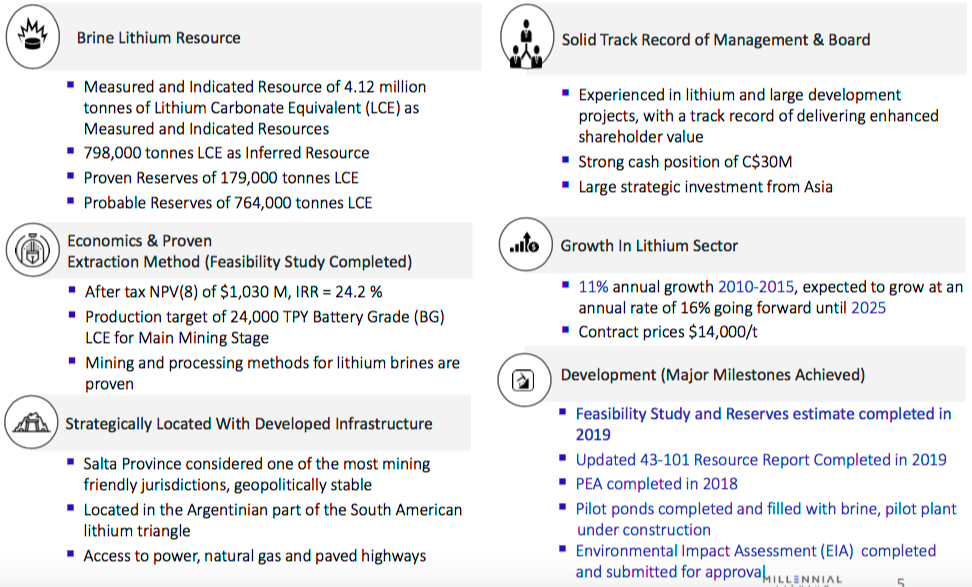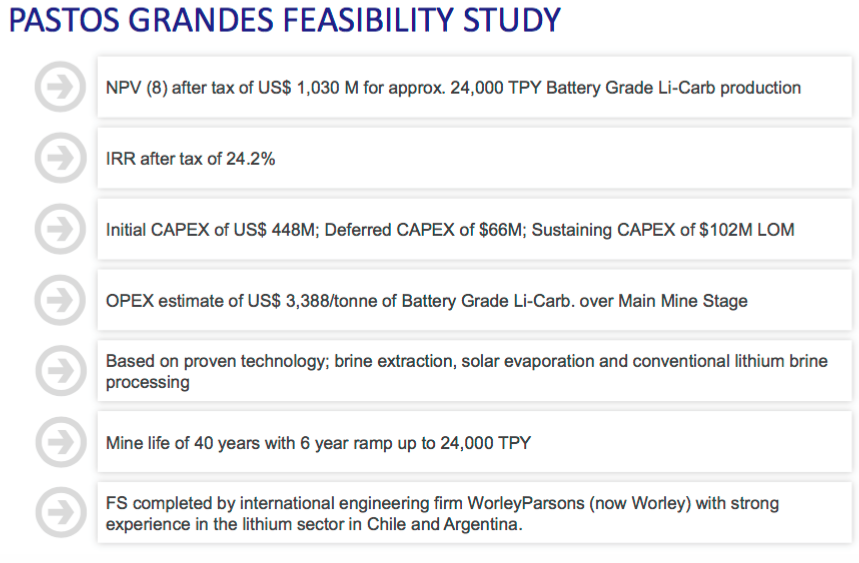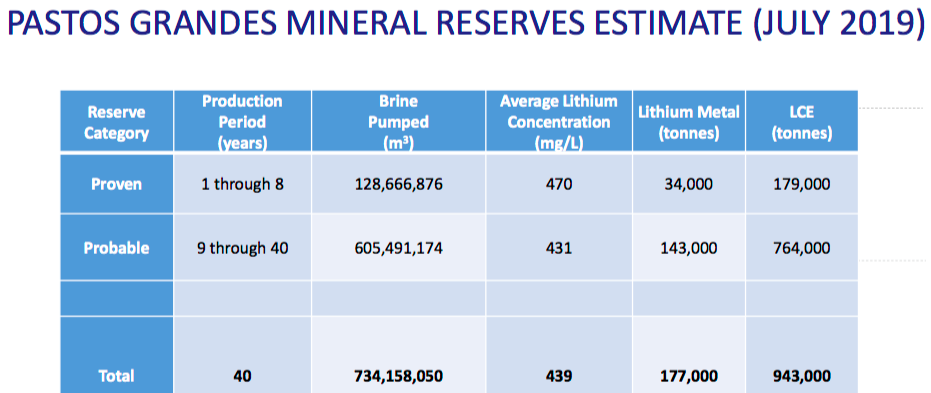The following CEO interview was conducted by email in the two weeks ended August 18th. At a time when “battery metals” junior mining companies have been stalled, not just lithium companies, but cobalt, vanadium and other high-tech, “green” metals, Millennial Lithium (TSX-V: ML) has advanced its flagship project Pastos Grandes all the way through a Bank Feasibility Study (“BFS“). And, the company still has approximately C$30 million in the bank.
Millennial’s BFS describes a lithium brine project that could reach commercial production in 2021. A pilot plant will be up and running later this year. Off-take discussions are well underway, and management’s goal is to have project financing arranged by year end. These are exciting times for the team.
This morning (August 19th), Lithium Americas (TSX: LAC) announced the closing of a US$160M cash injection from Ganfeng Lithium taking Ganfeng’s ownership in the Caucharí-Olaroz JV project from 37.5% to 50%. US$160M for an additional 12.5% values the project at US$1.28 billion, 50% attributable to LAC. Great news for Lithium Americas and for other advanced-stage lithium brine projects in Argentina, including Millennial’s 100%- owned Pastos Grandes.

Please give us the very latest snapshot of Millennial Lithium.
The big news for us is that we released a Bank Feasibility Study (“BFS“) on our flagship Pastos Grandes lithium brine project. The after-tax NPV(8%) of US$1 billion was 25% above the NPV(8%) number in the PEA.
We are one of just three or four companies with BFS-stage projects in Argentina, putting us we think 6-18 months ahead of most peers, some of whom will never reach BFS stage. The other two publicly-listed players, Australian-listed Galaxy Resources and Lithium Americas, have much larger market caps than we do, even after consideration of other projects they own.
We are building a pilot plant that will operate at 3 tonnes of lithium carbonate per month, allowing us to build up an inventory of finished product to send to customers and for ongoing test work. With a BFS and pilot plant in hand, we will be well positioned to talk to prospective strategic & financial parties, as well as potential off-take partners. Those discussions are underway.
Almost everyone agrees that demand for lithium will be off the charts by the mid-2020’s, but investment in the sector has been anemic. Is there a disconnect?
Unfortunately, there’s a lot of confusion in the market, helped along by self-proclaimed experts, most of whom have little experience with specialty chemicals in general, or lithium in particular. Keep one thing in mind, the oversupply in spodumene concentrate is related only to the shortage of available chemical conversion capacity in China. It has nothing to do with global demand for lithium chemicals.

While newsworthy setbacks on lithium projects such as Nemaska’s has created a heightened degree of uncertainty, the market could consume four times as much lithium carbonate in 2025 or 2026 than was produced last year. Increases in supply this year and next come nowhere near meeting this scale of growth. I find it hard to believe that the entire market could be in oversupply in the medium-term, notwithstanding short-term oversupply in the near-term.
What are the most important differences between Millennial’s PEA and your newly released BFS?
Good question. A key difference was that production of 25,000 tonnes/yr. in the PEA (20,000 tonnes battery grade (> 99.5% Li2CO3) and 5,000 tonnes technical grade), has been enhanced. The production rate in the BFS is 24,000 tonnes/yr., but its now 100% battery grade. Also, life of mine was extended from 25 to 40 years. Importantly, the level of accuracy in our BFS is much tighter at +15%/-15%, versus +35%/-35% in the PEA.
The cap-ex number in the BFS is 9% higher than that of the PEA due to three items. First, the addition of a final purification stage to ensure battery-grade (99.5% Li2CO3) lithium carbonate production. Second, the inclusion of a photo-voltaic plant to provide low-cost power, and third, an operations camp, (the PEA assumed the use of a contractor).
Op-ex increased by 5% due to higher usage and cost of reagents, primarily soda ash & lime, and the inclusion of the purification stage I mentioned. The BFS also included a pond expansion beginning in year 5 to maintain production levels and improve product quality. So, an increase of 9% & 3% in cap-ex / op-ex, but an increase of 25% in after-tax NPV and a higher degree of certainty in project fundamentals.

What are the primary business catalysts for the remainder of the year? First half of 2020?
The primary catalysts are the construction and start of a pilot processing plant, approval of our EIA by Salta province officials, securing off-take agreements, obtaining financial commitments and ongoing discussions with prospective strategic & financial partners in the lithium & energy industries.
What are the main takeaways of the BFS?
We maintained and/or improved many financial metrics. We reported an after-tax IRR of 24% (before tax 28%), and NPV8 of US$1 billion (before tax US$1.6 billion). All indications are that Pastos Grandes can be a successful, high-purity lithium carbonate producer with cap-ex & op-ex in line with other low-cost brine operations & projects in Argentina.
The BFS has op-ex at approx. $3,400 per tonne of battery grade lithium carbonate, placing the proposed operation in the lowest quartile of production costs, making it less vulnerable to lithium pricing and more attractive to funding partners.
Why aren’t giant car companies getting behind specific lithium projects or companies in Argentina? Toyota, Volkswagen, BMW, Nissan, Ford, GM, Honda — have market caps averaging over US$50 billion.

Automakers know the car business, not chemicals. Not since the days of Henry Ford have they had, or even exerted, direct presence in the materials supply chain. Large car companies are under the mistaken impression that lithium is a commodity, that supply can be, ‘switched on,’ at short notice.
The message has not seemed to penetrate this type of end-user — accustomed as they are to working at very large volumes, but low margins — that lithium supply is exactly the opposite.
No one can question Argentina’s mineral wealth, especially its lithium. However, the country has high inflation, a weak currency and a presidential election in 3 months. How risky is Argentina?
Country risk in Argentina is overstated due to ¨flashy¨ headlines. The population as a whole is well educated & productive, hampered only by a legacy of sub-optimal policies which are resolvable. As far as natural resources go, the country has low-cost lithium brine sources and a national mining law that is among the most transparent in the world.
Please brag about your management team, board & technical advisers.

We have an excellent & experienced team in place; both on the capital markets side and especially within our technical team. We have been a part of numerous mining successes including multiple M&A transactions. Given the strength of the Pastos Grandes project, we’ve been able to attract a world-class mining team; with experience in lithium project development, mining & processing. I invite readers to please visit our website for full biographies of our team.
Who are your largest shareholders?
By group, management & insiders are still the largest shareholder at approx. 20%. Hong Kong listed GCL, one of the largest solar power companies in the world, owns 17%. A number of other well known funds in Europe, Asia & North America own a combined 10%.
You moved directly from Preliminary Economic Assessment (“PEA”) to Bank Feasibility Study (“BFS”), skipping the Pre-Feasibility Study (“PFS”) that almost every other company does. How did your team get comfortable with this decision?
The main factor is that the Pastos Grandes brine reserve is relatively uncomplicated. While having to address normal issues associated with building & commissioning a new extraction operation and a high-purity chemical production facility, Millennial does not have to invent or develop anything new.
The process, already shown to work on our brine, is the norm in the industry. With no new technology to develop, prove and trial, we felt it was not necessary to extend the development path. As important, the team is highly experienced in specialty chemicals & lithium, from extraction through to marketing & strategy.

Funding Pastos Grande will be a major undertaking. What methods are you considering?
At this time, funding will most likely include a combination of standard project debt, equity & off-take agreements / pre-payments on off-take. We’ve been diligently working on project financing for Pastos Grandes over the past year. We hope to have our financing in place before year end.
Is there a scenario in which Millennial would not use solar evaporation ponds?
There are no plans, nor any need to alter course at this time. Testing & implementing direct extraction technologies would be expensive in terms of both time & cost. There is only one direct extraction operation in the world today, and available expertise to develop such an operation is very difficult to find.
Please explain how your team is interacting with local communities.
Millennial has enjoyed very good relations with the local community. Our two main projects include a joint business development and recreation building, designed so that the company and the community can work side-by-side for the benefit of the project, while also providing business opportunities for local residents. The most popular activity at this time is the commissioning of a new water well for the village.

Water supply to date has been from a surface stream. Drawing from surface water in an area with both humans and a robust domesticated animal population, has led to poor public health in the village. Millennial’s geologists identified and drilled a deeper well into a cleaner water aquifer. Testing proved that it is clear of contaminants, allowing us to install & commission a new local distribution system later this month.
Why should readers consider buying shares of Millennial Lithium over other lithium companies?
We have the right team in the right place at the right time. Despite fiscal challenges in Argentina, it’s still the first or second best places on earth to harvest lithium with solar evaporation ponds. Lithium prices have come down from very high levels, but we don’t need a high lithium price next year or the year after. By the time we’re ramping up production we expect prices to be stronger.
We have an advanced-stage project with a BFS on it. As end-users figure out that global supply of battery-grade lithium is highly uncertain, they will turn to the most advanced projects. Our Pastos Grandes project, Lithium Americas’ JV project with Ganfeng, and Galaxy’s Sal de Vida project are, without question, three of the most advanced brine projects in the world. We have about $30M in cash, enough to fund us into next year.
Disclosures: The content of this interview is for information only. Readers fully understand and agree that nothing contained herein, written by Peter Epstein of Epstein Research [ER], (together, [ER]) about Millennial Lithium., including but not limited to, commentary, opinions, views, assumptions, reported facts, calculations, etc. is not to be considered implicit or explicit investment advice. Nothing contained herein is a recommendation or solicitation to buy or sell any security. [ER] is not responsible under any circumstances for investment actions taken by the reader. [ER] has never been, and is not currently, a registered or licensed financial advisor or broker/dealer, investment advisor, stockbroker, trader, money manager, compliance or legal officer, and does not perform market making activities. [ER] is not directly employed by any company, group, organization, party or person. The shares of Millennial Lithium are highly speculative, not suitable for all investors. Readers understand and agree that investments in small cap stocks can result in a 100% loss of invested funds. It is assumed and agreed upon by readers that they will consult with their own licensed or registered financial advisors before making any investment decisions.
AX1 Capital Corp. retained Epstein Research for a six-month advertising campaign. AX1 Capital is closely affiliated with Millennial Lithium. It is 100%-owned by a single individual who has a contract for services with Millennial Lithium. This individual owns 150,000 restricted share units and a similarly modest number of warrants in the company. Therefore, readers should consider Epstein Research [ER] to be biased in favor of Millennial Lithium. Peter Epstein of [ER] does not own any shares, warrants, options or restricted share units of Millennial Lithium.
Readers understand and agree that they must conduct their own due diligence above and beyond reading this article. While the author believes he’s diligent in screening out companies that, for any reasons whatsoever, are unattractive investment opportunities, he cannot guarantee that his efforts will (or have been) successful. [ER] is not responsible for any perceived, or actual, errors including, but not limited to, commentary, opinions, views, assumptions, reported facts & financial calculations, or for the completeness of this article or future content. [ER] is not expected or required to subsequently follow or cover events & news, or write about any particular company or topic. [ER] is not an expert in any company, industry sector or investment topic.
![Epstein Research [ER]](http://EpsteinResearch.com/wp-content/uploads/2015/03/logo-ER.jpg)





